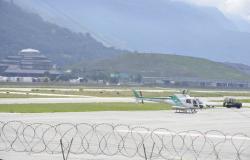MESAGNE – It’s the day of the first arrivals. In these hours there is a lot of activity in Piazza Orsini del Balzo and in the rooms on the main floor of the Norman-Swabian Castle of Mesagne, which hosts the exhibition “G7. Seven centuries of Italian art”, organized by Puglia Walking Art and the Rete di Puglia Micexperience enterprise, with the patronage of the Puglia Region and the Municipality of Mesagne, the Taranto-Brindisi Chamber of Commerce and the Puglia Airports. A collateral event at the international summit of Borgo Egnazia, the exhibition will be inaugurated on June 13th and, with the scientific curation of professor Pierluigi Carofano, it will be the key cultural event of the summer and autumn in Puglia, given that it will close its doors on Saturday Next November 30th.
In these hours, two works have arrived from the Mart (Museum of Modern and Contemporary Art of Trento and Rovereto): the Kiss between Dante and Beatrice (oil on canvas, 128.5×128.5×6 cm), by the only living artist on display among masterpieces of seven centuries of Italian art, the Tarantino Roberto Ferri; and, an example of Futurism, the oil on panel (103.5×88.5×4 cm) by Fortunato Depero (1892-1960).
However, the Roman museum institutions and private collections are the masters in these first hours of actual preparation. Ideally leading the group, without detracting from the value of the other works, is the “painter of the British”, Giovanni Antonio Canal, known to all as “il Canaletto” (1697-1768), whose work is presented to the public for the first time the Entrance to the Grand Canal with the view of the Salute church (oil on canvas, 108×130 cm), a detail of which was chosen by the organization of the exhibition to promote the event.
As if that work were not already precious, here comes the Madonna of the spindles from the Museum of Palazzo Costa in Piacenza (oil on panel transferred to canvas, 73×60 cm) from Leonardo’s workshop and the masterpiece by Salvator Rosa (1615-1673) Mario in front of the ruins of Carthage, which in the past was chosen as the cover of the prestigious English art history magazine, “The Burlington Magazine” (oil on canvas, 192×135 cm); from the National Gallery of Modern Art the Black white black of 1955, exhibited at the Venice Biennale in 1956 (zipper, fabrics, plastics, oil and zinc white on jute canvas, 150x250x3.5 cm) by the master of the Informal Alberto Burri (1915-1995), while from the National Museum of Castel Sant’Angelo the tempera panel painted by Lorenzo Lotto (1480-1556/7), depicting the penitent Saint Jerome (85×104.5 cm). From a private collection comes the pre-Caravaggesque Mangiafagioli (oil on canvas, 106×90 cm) by Vincenzo Campi (1536-1591 and, from the Roman province, from Palazzo Chigi in Ariccia, Baroque Museum, one of the most beautiful works by Mattia Preti (1613 -1699), Campaspe (oil on canvas 180×133 cm).
Stay updated on news from your province by subscribing to our whatsapp channel: click here.






